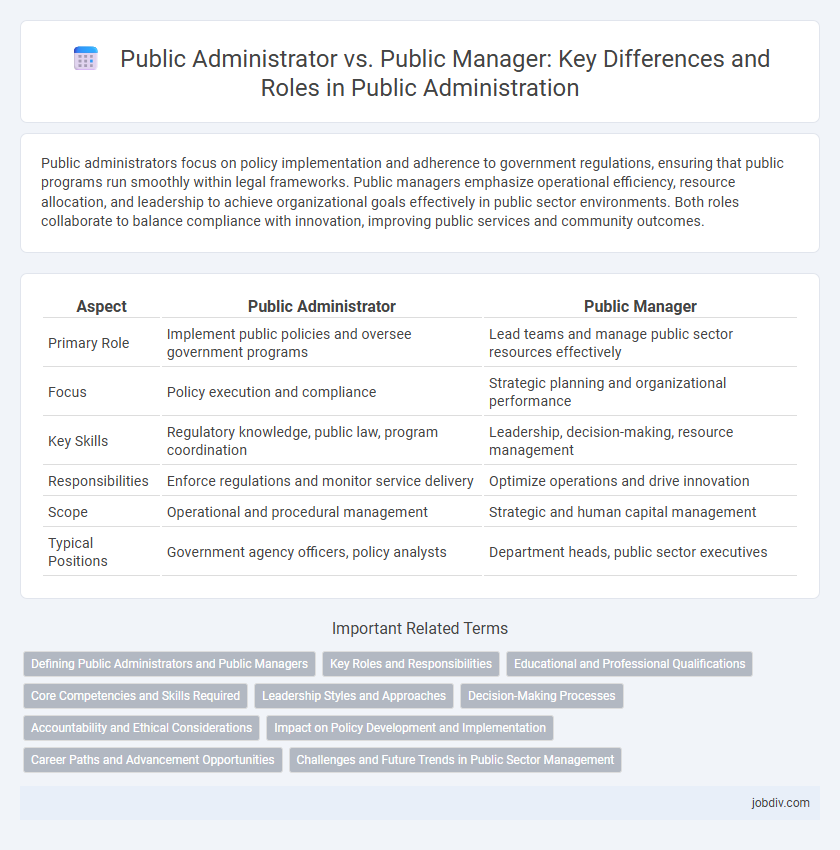Public administrators focus on policy implementation and adherence to government regulations, ensuring that public programs run smoothly within legal frameworks. Public managers emphasize operational efficiency, resource allocation, and leadership to achieve organizational goals effectively in public sector environments. Both roles collaborate to balance compliance with innovation, improving public services and community outcomes.
Table of Comparison
| Aspect | Public Administrator | Public Manager |
|---|---|---|
| Primary Role | Implement public policies and oversee government programs | Lead teams and manage public sector resources effectively |
| Focus | Policy execution and compliance | Strategic planning and organizational performance |
| Key Skills | Regulatory knowledge, public law, program coordination | Leadership, decision-making, resource management |
| Responsibilities | Enforce regulations and monitor service delivery | Optimize operations and drive innovation |
| Scope | Operational and procedural management | Strategic and human capital management |
| Typical Positions | Government agency officers, policy analysts | Department heads, public sector executives |
Defining Public Administrators and Public Managers
Public administrators are government officials responsible for implementing policies, managing public programs, and ensuring compliance with regulations to serve the public interest effectively. Public managers focus on strategizing, organizing resources, and leading teams within public organizations to achieve operational goals and improve service delivery. Both roles require strong leadership and management skills, but public administrators emphasize policy execution while public managers prioritize operational efficiency.
Key Roles and Responsibilities
Public Administrators oversee policy implementation, ensuring government programs align with legal frameworks and public interests, while managing resources and regulatory compliance. Public Managers focus on operational efficiency, supervising staff, optimizing workflows, and delivering public services effectively to meet community needs. Both roles require strategic planning and stakeholder communication but differ in emphasis on governance versus operational management.
Educational and Professional Qualifications
Public Administrators usually hold advanced degrees in public administration, political science, or public policy, often supported by certifications like Certified Public Manager (CPM) or Public Administration Certification. Public Managers typically possess specialized professional qualifications aligned with management roles, such as an MBA or project management credentials, emphasizing operational leadership within government or nonprofit organizations. Both fields value experience in public sector environments, but Public Administrators focus more on policy analysis and governance, whereas Public Managers prioritize organizational efficiency and team leadership.
Core Competencies and Skills Required
Public administrators excel in policy analysis, budgeting, and regulatory compliance, emphasizing strategic planning and public accountability. Public managers focus on operational leadership, team management, and performance evaluation, requiring strong communication and problem-solving skills. Both roles demand proficiency in ethical decision-making, resource allocation, and stakeholder engagement to effectively serve community needs.
Leadership Styles and Approaches
Public Administrators typically employ a bureaucratic leadership style emphasizing policy enforcement, rule adherence, and hierarchical decision-making to ensure public accountability and transparency. Public Managers adopt a more transformational leadership approach, focusing on innovation, team motivation, and adaptive problem-solving to drive efficiency and responsiveness in public service delivery. The contrast in leadership styles reflects their distinct roles: administrators prioritize regulatory compliance, while managers emphasize strategic change management.
Decision-Making Processes
Public administrators primarily implement policies and ensure compliance through standardized decision-making frameworks, emphasizing rule-based and procedural approaches. Public managers engage in strategic decision-making that often involves resource allocation, change management, and stakeholder negotiations to achieve organizational goals. The distinction lies in administrators focusing on consistency and regulation, whereas managers prioritize adaptability and innovation in decision processes.
Accountability and Ethical Considerations
Public administrators are primarily responsible for ensuring transparency and accountability in policy implementation, adhering strictly to ethical standards set by government regulations and public service codes. Public managers focus on operational efficiency while upholding ethical considerations by fostering organizational accountability and promoting integrity in managing public resources. Both roles demand rigorous adherence to ethical frameworks to maintain public trust and ensure responsible governance.
Impact on Policy Development and Implementation
Public administrators primarily focus on executing policies by managing government programs and ensuring compliance with regulations, directly influencing the efficiency and effectiveness of policy implementation. Public managers play a critical role in shaping policy development through strategic decision-making, resource allocation, and stakeholder engagement, which shapes the direction and priorities of public programs. Their collaboration enhances the translation of policy objectives into actionable outcomes, driving public sector innovation and responsiveness.
Career Paths and Advancement Opportunities
Public Administrators typically engage in policy development and oversee public sector programs, providing a foundation for advancement into senior governmental roles or elected positions. Public Managers focus more on the operational side, managing teams and resources within public agencies, which can lead to higher management roles or executive appointments. Both career paths offer distinct advancement opportunities, with Public Administrators leaning toward strategic influence and Public Managers toward organizational leadership.
Challenges and Future Trends in Public Sector Management
Public administrators face challenges including bureaucratic inertia, complex regulatory compliance, and stakeholder accountability, while public managers must address dynamic resource allocation, technological integration, and performance metrics optimization. Emerging trends emphasize digital transformation, data-driven decision-making, and enhanced citizen engagement methods to improve transparency and service delivery in the public sector. Future public sector management increasingly relies on adaptive leadership, cross-sector collaboration, and sustainability-focused policies to respond to evolving societal needs and global challenges.
Public Administrator vs Public Manager Infographic

 jobdiv.com
jobdiv.com